#Bell beaker culture
Text

i hope when i die someone will treat me with the same care and love, gently placing me in my grave and putting my jewellery on...
“Towards the Bronze Age in south-eastern Poland (2300-2000 BC)” by Piotr Włodarczak
#archaeology#bronze age#neolithic#funerary rites#burial#corded ware#corded ware culture#bell beaker culture#mierzanowice culture#my upl
100 notes
·
View notes
Text


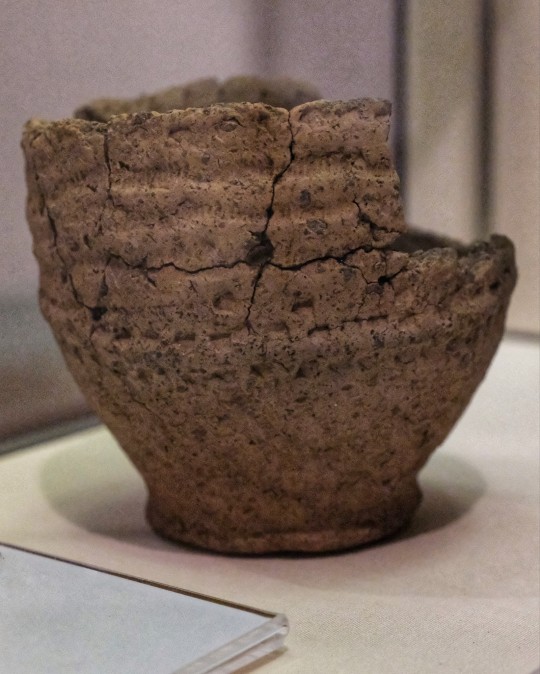


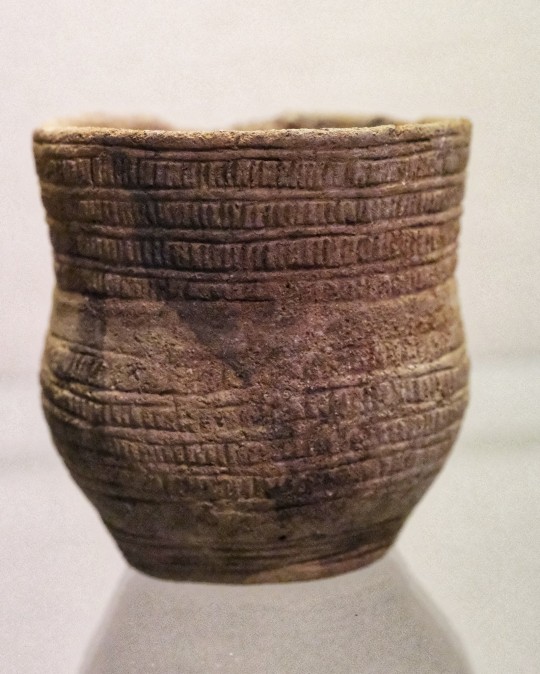
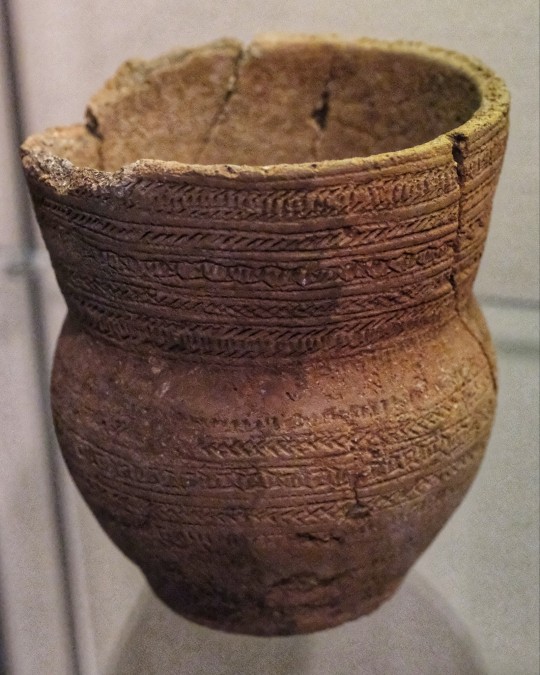

Prehistoric Pottery Photoset 2, Inverness Museum and Gallery, Inverness, Scotland
#ice age#stone age#bronze age#copper age#iron age#neolithic#mesolithic#calcholithic#paleolithic#prehistory#prehistoric#prehistoric pottery#pottery fragments#pottery#beaker#bell urn#collared urn#urn#ancient craft#ancient culture#ancient living#Scotland#archaeology
46 notes
·
View notes
Text
finally watched barbie last night. i think it was refreshing to see gerwig's exploration of population exchange in europe during the chalcolithic age. barbies are clearly coded to be early european farmers, living in a comfortable yet stagnant environment of europe at the tail end of the ice age, with a culture revolving around female fertility (notice the second character introduced is a pregnant barbie). the second sequence shows up ken(gosling)'s enterance into the story on beach, mirroring the arrival of western steppe herder cultures as glaciers in europe retreated.

once barbie and ken venture into the "real world" (prohpetic vision of the bronze age), ken adopts advanced technologies like the horse (horse), patriatrchy (worship of a male solar deity), and cars (the wheel, expoundable into the horse-driven chariot). his donning of the fringe jacket and cowboy hat stir within the audience a yearning for westward expansion, from the pontic steppe through the pannonian basin and beyond.

ken transforming barbieland into the kendom mirrors the replacement of early european farmer (vinča, varna cultures etc.) with corded ware and bell beaker cultures, settled iterations of the kens' previously pastoral culture. the only barbie not assimilated into the new cultral zeitgeist is weird barbie (basques), herself a cultural isolate even compared to other barbies pre-invasion.
the final battle scene between the two ken factions places particular focus on archery, hallmark of the mongol civilization, which was the last of the steppe invasions of europe. notice in this situation, gerwig's bravery in correctly having ken (asian) represent the kingdom of hungary (asian), whereas ken (gosling) is of course the ever-lasting scythian spirit emanating from the steppe. some scholars have suggested the light-blue void where the last battle takes place to be a metaphor tengri.
some other stuff happened as well but i didn't really get how that fit into the greater story i guess. what was the deal with the old jewish lady LOL !
5K notes
·
View notes
Text
Sooner or later I've gotta make a better post regarding the appropriation of indigenous terminology by proponents of (certain kinds of) Welsh nationalism. But for now here's a very whistle-stop version of that post. I have a degree in Celtic Studies so these topics are very near and dear to my heart.
[Note: I wrote this post originally during a migraine. I'm revisiting the draft while I'm ill but hopefully can fix this up into something somewhat understandable. As always, this is only a very brief description of the history and I strongly reccomend reading about these topics in your own time to develop a deeper understanding of them. These are topics not even well known in Britain, but if you can spend a short time just to read this, you can help to combat misinformation about British (particularly Welsh) history - and that could aid in preventing the misappropriation of history in the long run. Diolch eto for reading!]
Very often, (certain) Welsh nationalists use terminology that positions the Welsh as if they are an 'indigenous' population who have been 'colonised'. They use language (which in this climate) heavily draws upon the language typically used for peoples who are the victims of British colonialism (of which Wales was an active participant). There's multiple issues with this and many of them lie in whether its appropriate to use this language (regardless of its accuracy or not) as a country which was actively involved in the colonisation of much of the world. What I mean in short is that additional language is needed which doesn't step on the toes of endangered cultures and groups directly affected by British colonialism.
Wales not only participated in British colonialism as a whole (alongside Scotland, Ireland* and England) but itself colonised parts of patagonia in Argentina.
I can't think of any similar terminology to 'indigenous' or 'colonised' which would also get the idea which is meant across. 'Native' in certain contexts is permissible, e.g. 'native speaker' in the context of a Welsh speaker. But in other contexts other than langauge, things get tricky when you argue 'nativeness' (this is a topic I will come back to - especially re. Celtic as a language descriptor vs Celtic as a so-called ethnicity). When (certain) Welsh nationalists talk about being 'indigenous' , being 'native' or 'colonised' what is meant by that?

(Map of the expansion of the Bronze Age Bell Beaker culture circa 2400 BC in Britain and Ireland) - from this map
What makes a Welsh person 'indigenous' to this island that doesn't immediately disqualify other peoples who also have a deep history here? Historically, the island of Britain has been lived on by many, many peoples.
In the Bronze Age you had the arrival of the Bell Beaker people. Then in the Iron-Age, you had tribes speaking (mostly) Brittonic. I say mostly, because we have direct evidence that in the Iron Age Gaulish speaking tribes also moved to parts of Britain but later became integrated with the rest of the population (which, I will add, were not a united peoples but a scattering of different groups who often went to war against each other). Then the Romans invaded Britain (and much of Western Europe) and over time integrated into the local population. So now Britain is Romano-British. Eventually the Western Roman Empire collapses and Britain enters into the sub-Roman Britain phase of its existence. Kingdoms begin to form, with the population speaking Brittonic and British-Latin. So you have different kingdoms in (what would become Wales) and in (what would become Northern England and Southern Scotland) you have more Brittonic-speaking kingdoms.
These kingdoms were also not a united peoples. They shared a language - but it's like claiming that Ancient Greeks were a united people simply because they all spoke Greek. Sparta, Athens, Cornith etc. were independent of each other and the same is true of the kingdoms of the Hen Ogledd (the Old North) and the kingdoms of Wales. They all had a common language but also went to war with each other sometimes. Eventually, the Brittonic language began to diverge into different languages. Namely, Old Welsh and Cumbric (the language spoken in what is today Cumbria, Lancashire, Northumberland and Southern Scotland). The two languages were still very closely related but had diverged by a certain point.
At the same time this is happening, Anglo-Saxons begin to arrive in what is now Kent. They form kingdoms and the Britons living there are either displaced or become absorbed into the Anglo-Saxon populace. Then the Norse rock up and conduct viking raids around the coast before finally settling in parts of the country and forming their own territories.
So now Britain has several groups living on the island (keeping in mind even before settlement from the Anglo-Saxons and the Norse that the British kingdoms were already composed of different groups themselves). Northern Scotland was also having a time re: Picts, Gaels and Britons - but we'll gloss over that for brevity. Also, Ireland was also raiding the Welsh coast at this time too.
Then the Normans rock up and in 1066 William the Conqueror, well, conquers. More history happens after this point but I will try and keep this as brief and as non-messy as I can.
So, to recap:
One of the earliest cultures in Britain was the Bell Beaker people in the Bronze Age. They had their lands settled by the Iron Age Britons ('Celts'). Then the Romans came and the 'Celts' became Romano-Britons. After the Western Roman Empire collapses the remaining population forms kingdoms with distinct political identities. These kingdoms eventually find themselves fighting the Anglo-Saxons and the Norse. Then the Normans turn up and so on and so forth.
So- which group is the original native group to Britain? (Trick question - this question cannot be satisfactorily answered in favour of one group without leaning into claims of historicity which the other groups can also claim).
Which brings me to modern Welsh identity and those who came before.
Something I see in Welsh nationalist groups is a claim to the legacy (or even claims of direct descendance from) the Iron Age Britons (commonly called Celts for shorthand, but as I said before I'm gonna get back to that point). And this narrative is what the "Welsh people are native to Britain" argument is based off of.
It may seem like #praxis to argue the Welsh people are the true inhabitants of Britain and the English are evil invaders. But you have to make *several* logical leaps to get to that point if you're genuinely arguing that point.
For starters, many more people than just the Britons (read: Romano Britons/early Brittonic kingdoms) have called Britain home since the Early Middle Ages. For example, there's the settlement of Scotland by the Gaels, the Irish settlement of certain parts of costal Wales. You have (much later) Roma and traveller groups, Jewish diaspora and many more diverse cultures and peoples existing in Britain at this time. The Romano-British population, which developed into the Early Middle Ages kingdoms of Wales and the Hen Ogledd, was also multicultural. Many black Romans started families with white Britons. By the sub-Roman period, Britain was ethnically and culturally diverse.
But those who argue in favour of a such thing as 'Celtic ethnicity' in order to support the idea Britons (and only Britons) were native to these islands typically imagine that history as white. White Brits, white Romans, white Gaels. When we know this isn't true. Did you know that the Northernmost Ancient Egyptian temple in the world is in Yorkshire because Roman Egyptians in the military brought their religion with them? Mary Beard did a fantastic documentary about a Roman Soldier from modern day Syria who was stationed at Hadrian's Wall who started a family with a British woman. Point is, that some people like to imagine a purely white Britain that they can pine for. And I'm afraid it simply isn't true. The version of history many white supremacists look to simply didn't exist.
I'll quickly bring up one last point before I draw this to a close. And it's about Celtic as a linguistic term vs Celtic as a so-called ethnicity. You see, any first year Celtic Student would tell you that there is no such thing as 'Celts'. Crazy, I know from people studying *Celtic* studies. But hear me out - there is good reasoning why (beyond language groups) Celtic is not a good term for describing an ethnic group. Much of it relates to what I've already mentioned, but we categorise Ireland, Scotland, Wales, Mann, Cornwall and Brittany as Celtic not because of the ethnicity of the people living there (which I've mentioned is pretty diverse) but because they are all places where Celtic languages are spoken. It wasn't until Edward Llwyd (d. 1709) that the term Celtic was coined to describe these languages. Up until that point, nobody was thinking of Irish and Welsh as related because the languages do not sound like they have a common origin. By extension, people didn't think of the Welsh and Irish as being the same peoples (or Celtic) either. Its only in the modern day there is a sense of Celtic identity. The Iron Age Britons were not going around calling themselves Celts. There was no common Celtic identity. But very often people argue Celticness based on a pseudohistory which insists on a false and misleading interpretation of history. Whether or not Celticness exists now is a different matter entirely. But it sure does not rest upon race or ethnicity as a qualifier. This is quite foundational stuff to first year and above Celtic Scholars, but is not generally well known outside of academia because the misinformation is quite strong. So if you read is far, diolch mawr and please share this with anyone you think might be interested in it. Any amount of knowledge of these things would greatly improve understanding of what it means to be Welsh and what it means to speak a Celtic language.
Lastly,
all of that begs us to ask the question:
What does it mean to claim nativeness in a Western European context?
More under the cut
What does it mean to claim nativeness in a Western European context? Especially in a Western Europe post-colonialism.
It means, to me, to claim what isn't our right to claim. To argue and make our points with language that isn't ours and isn't designed to be ours. That this language of indigeneity may sound appealing, but is it improper to use this terminology when our country was directly responsible for the atrocities in which this very language became relevant?
What do we do in response to the misinterpretation of our culture instead of relying on language of indigeneity? These are the questions I want to leave you with and invite you to share your thoughts on. How do we build a Wales which advocates for itself without relying upon inaccurate language which betrays a reliance upon the ahistorical to make its point?
What kind of Wales do we want to live in?
#cymraeg#welsh#cymru#cymry#cymblr#Wales#welsh language#welsh nationalism#nationalism#indigeneity#?#white supremacist mention#white nationalism cw#please add on if you have any thoughts on the matter - I'd love to hear other's takes on the topic!#this post was also mostly made when I was ill/had a migraine so it may not be perfect#but gets most of what I want across well enough I think
103 notes
·
View notes
Photo
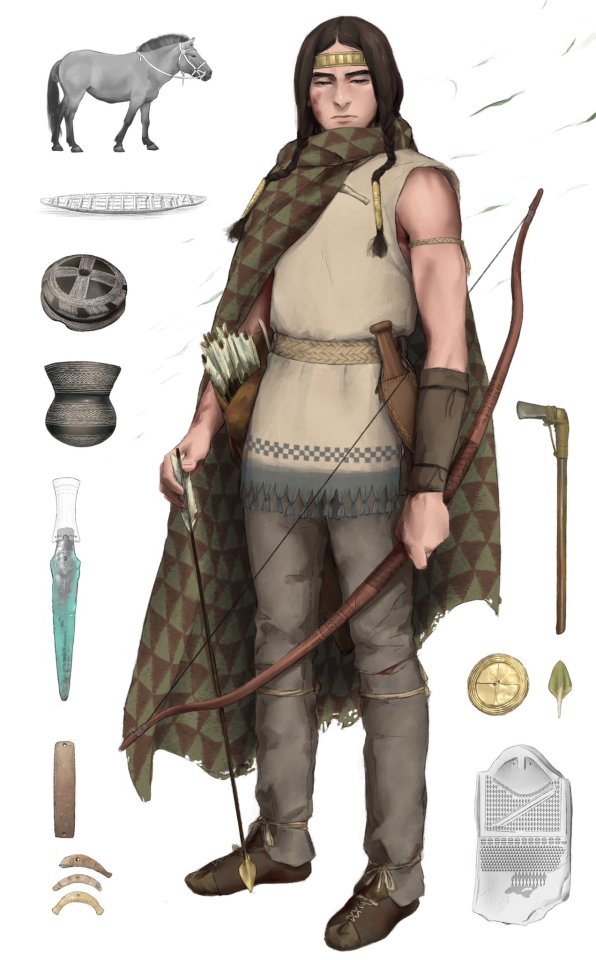
"The Prince", elite man of the Bell Beaker Culture. Western Europe, Late Neolithic and Early Bronze Age (2800-1800 BC).
11 notes
·
View notes
Text
Say hello to an ancestoress
More than 4,000 years ago, a young woman who died in what is now Scotland was buried in a crouched position within a stone-lined grave. She remained buried for millennia, until excavators at a stone quarry unexpectedly unearthed her bones in 1997.
Little is known about the woman — dubbed Upper Largie Woman after the Upper Largie Quarry — but now, a new bust-like reconstruction reveals how she may have looked during the Early Bronze Age.
The reconstruction, which went on display Sept. 3 at the Kilmartin Museum in Scotland, shows a young woman with dark braided hair who is wearing a deer-skin outfit. And she appears to be looking at someone nearby.
"Making a reconstruction I usually think that we are looking into their world, [meaning] they don't see us," Oscar Nilsson, a forensic artist based in Sweden who crafted the woman's likeness, told Live Science in an email. "I thought it could be an interesting idea to twist this a bit, and actually thinking that she can see us. And as you can see, she looks a bit critical to us (I don't blame her for that...)!"

Upper Largie woman, who died in her 20s, lived during the early Bronze Age of Scotland. (Image credit: Oscar Nilsson)
After the discovery of Upper Largie Woman, a skeletal and dental analysis revealed that she likely died in her 20s and experienced periods of illness or malnutrition. Radiocarbon dating found that she lived between 1500 B.C. and 2200 B.C., during the Early Bronze Age, according to the museum. Meanwhile, a look at different isotopes, or versions of strontium and oxygen from her remains suggested that she grew up locally in Scotland, but the team wasn't able to extract her DNA, so her ethnic heritage, including her skin, eye and hair color, is unknown.
However, archaeologists found sherds of Beaker pottery in her grave, hinting that she was part of the Beaker culture, named for its peoples' bell-shaped beakers. Research suggests that the Beaker culture started in Central Europe with people whose ancestors came from the Eurasian Steppe. Eventually, the Beaker culture reached Britain in about 2400 B.C. DNA evidence indicates that the Beaker culture replaced most of Britain's inhabitants, including the Neolithic communities that had built monuments such as Stonehenge.
"The carbon dating suggests she might be a descendant of the first Beaker newcomers," Sharon Webb, director and curator of Kilmartin Museum, told Live Science in an email.
For the reconstruction of Upper Largie Woman, her skull was CT (computed tomography) scanned and then 3D printed in Scotland. However, "she lacked her mandible [lower jaw], and her left side of the cranium was in a quite fragmented condition," Nilsson said. "So, the first thing I had to do was to rebuild the left side of her cranium. And then to create a mandible, a rather speculative issue of course."
Then, Nilsson took her age, sex, weight and ethnicity into account, as these factors help determine tissue thickness. "So, in this case: a woman, about 20-30 years of age, signs of undernourishment in a period of her life, and a probable origin from the region," he said.
Nilsson pulled from a chart of modern individuals who fit these characteristics, then used their tissue measurements to begin sculpting the reconstruction. Pegs placed on the replica skull helped him measure the tissue depth, which he then covered with plasticine clay as he molded the facial muscles. Based on her skull's contours, he noted that Upper Largie Woman's eyes were wide set and that her nose was broad and "probably a bit turned upwards." She also had a rounded forehead and a broad mouth.
"I found it interesting that once she was reconstructed, I did not see that much of her malnutrition," Nilsson said. "She had a very rounded facial skeleton, which helped her looking a bit more healthy than she may have been."
However, he was clear that "the colors were all qualified guesses, based on other burials from the time and the region, where the DNA was in better shape than this one."
Webb called the reconstruction "absolutely amazing, we wanted her expression to be asking questions of the visitor, wondering who they are, and what their lives were like so that visitors might also ponder her life."
Upper Largie Woman's remains are now "sensitively 'reburied'" in the same position and orientation she was likely buried in 4,000 years ago, Webb said. Visitors can see her reconstruction at the museum's permanent exhibit.
#Women in history#scotland#Upper largie Woman#Kilmartin Museum#I don't blame her either#Oscar Nilsson#Early Bronze Age#Beaker culture
18 notes
·
View notes
Photo
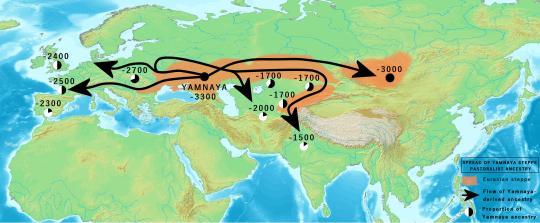
Spread of proto Indo-European (Yamnaya) ancestry up to 1500 BC.
Expansion of Yamnaya-related people, according to Anthony (2007), 2017; Narasimhan et al. (2019); Nordqvist and Heyd (2020),
3000 BC: Initial eastward migration initiating the Afanasievo culture, possibly Proto-Tocharian.
2900 BC: North-westward migrations carrying Corded Ware culture, transforming into Bell Beaker; according to Anthony, westward migration west of Carpatians into Hungary as Yamnaya, transforming into Bell Beaker, possibly ancestral to Italo-Celtic (disputed).
2700 BC: Second eastward migration starting east of Carpatian mountains as Corded Ware, transforming into Fatyanovo-Balanova (2800 BC) → Abashevo (2200 BC) → Sintashta (2100–1900 BC) → Andronovo (1900–1700 BC) → Indo-Aryans
132 notes
·
View notes
Text
An ancient connection between communities in Britain and Luxembourg has been discovered through the latest Bronze Age burial study. Researchers have unearthed compelling genetic evidence suggesting a patrilineal descent system within the Bell Beaker culture, revealing deep-rooted family ties across Europe.
6 notes
·
View notes
Text
Pre-Roman Timeline of Europe




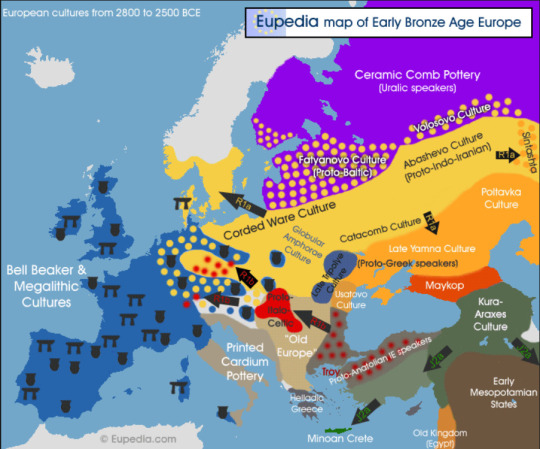
Neolithic Cultures: 6000 BC - 3000 BC
Bronze Age Influence: 4000 BC (pre-Yamnaya) - 2000 BC
Megalithic Era: 3000 BC (Yamnaya Expansion)
Corded Ware Culture: 3000 BC - 2500 BC
Bell Beaker Culture: 2800 BC - 2200 BC
Unetice Culture: 2200 BC - 1600 BC
Tumulus Culture: 1600 BC - 1300 BC
Unfiled Cultures: 1300 BC (Bonze Age Collapse & Rise of Celtic Culture) - 750 BC
Hallstatt Culture: 1200 BC - 500 BC (Rome founded in 753 BC)
La Tene Culture: (450 BC - 43 AD)
Roman Era: (50 BC - 476 AD)
Dates are not approximate
#indo european#celtic#celts#urnfield culture#anthropology#history#archeology#europe#pottery#time line#rome
2 notes
·
View notes
Text
it's kinda really funny to me that a lot of cultures are named after their drinking vessels (linearbandkeramic & bell beaker, for example). if an archeologist saw my room they would say i was of the Too Many Mugs People
4 notes
·
View notes
Note
Little confused here. I understand that Germanic culture emerged from the Late NBA, but in your video, “The development of Germanic material culture” you said “Germanic culture begins with the Battle-Axe culture.” Also in your awesome speech which I loved, “the History of Britain and her people,” you said “the lower Rhine Bell-Beaker culture gave birth to the Celtic peoples and the Germanic peoples.”
The first video you mention is from 5 years ago. The video traces material culture not language. The BAC introduced IE culture to Scandinavia and in that way is ancestral to the Germanic culture but is not the source of Germanic language.
The BBC culture of the Rhine area expanded south to central europe where it mixed with others to form Celtic (see my video on origin of celts) but it also went north east and mixed with SGC and BAC to form Germanic culture. Whether Celtic or Germanic languages come from BBC is impossible to tell but the BBC are certainly ancestral to both peoples.
9 notes
·
View notes
Photo

reconstruction of a male burial from the bell beaker culture
Museo Arqueológico Nacional
ph. Miguel Hermoso Cuesta
#archaeology#bell beaker culture#neolithic#prehistory#prehistoric europe#funerary rites#burial#my upl#museum
7 notes
·
View notes
Text
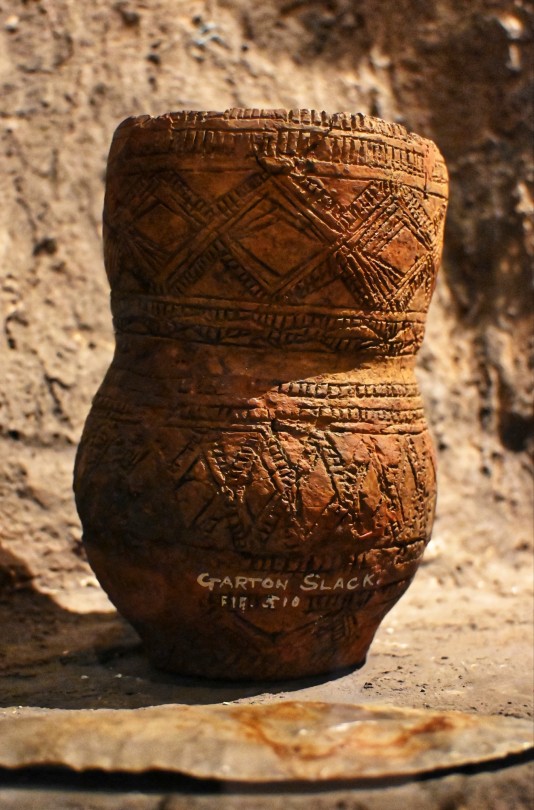

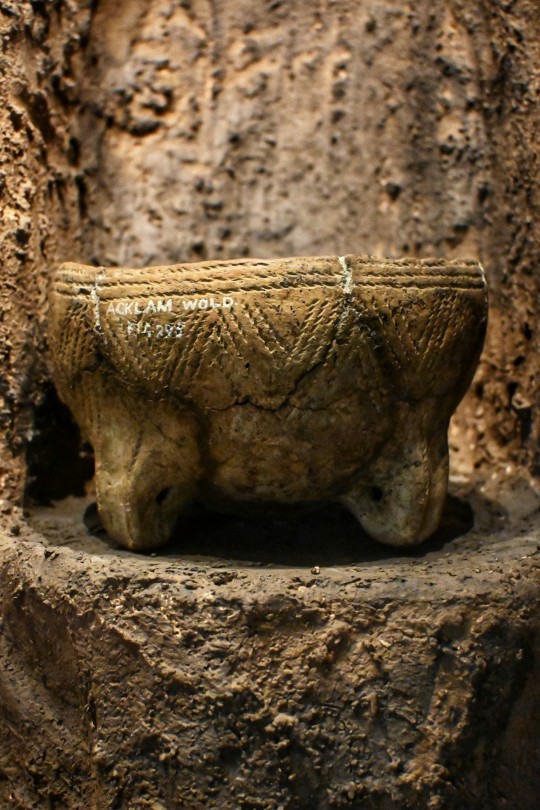
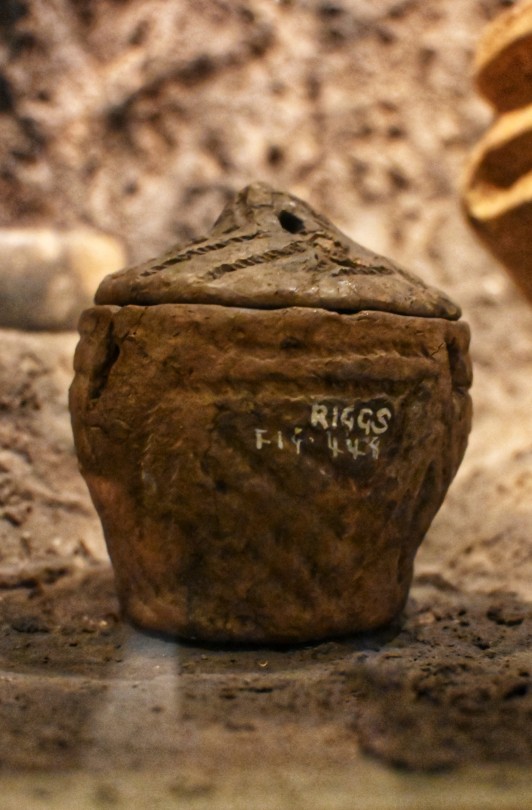


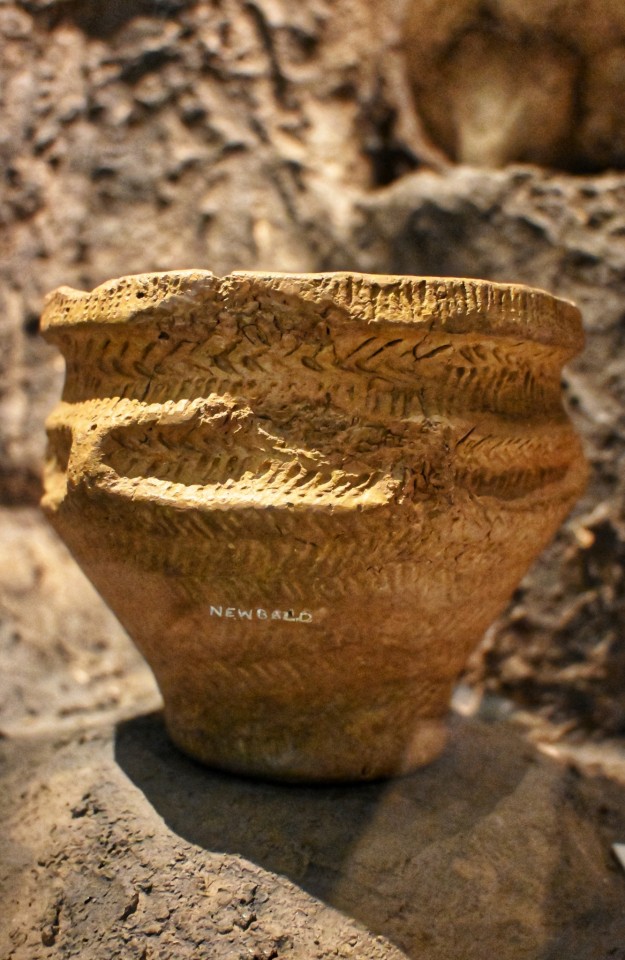


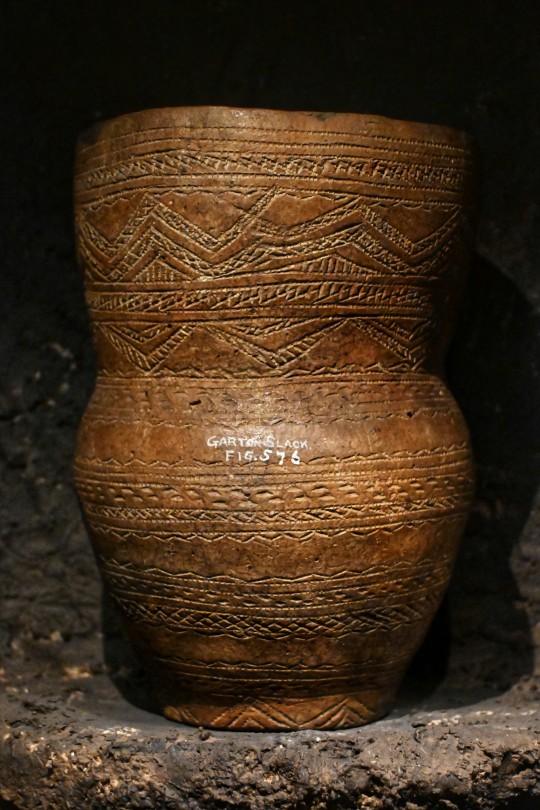
Prehistoric Pottery Photoset 1, Hull and East Riding Museum, Hull, Yorkshire
#ice age#stone age#bronze age#copper age#iron age#neolithic#mesolithic#calcholithic#paleolithic#prehistoric#prehistory#prehistoric pottery#pottery#pottery fragments#urn#bell urn#beaker#ancient living#ancient craft#ancient culture#burial chamber#burial mound#burial ground#archaeology#relic
47 notes
·
View notes
Text
*holds hand out to u* let's think about bell beaker culture together :)
#sarah why#gonna remake this post every day with a different ancient era#whichever one i'm thinking about the moment#actually earlier today it was the scythians and i am kinda still on that
2 notes
·
View notes
Text
once again reflecting on how weird and also appropriate it is to be old enough that many things have been reclassified or renamed or re-explained in our lifetime - this time it's learning that what we were taught in school as The Beaker People (a lovely whimsical name made all the better by the arrival of the muppets) is now called The Bell Beaker Culture and while it's lost some whimsy as a title, it's gained some accuracy it didn't have before, and this is our message of encouragement to let yourself let go of old understandings when new and better ones come along
also another reminder (because whimsy):
beauty and impermanence are belovèds
you couldn't experience beauty if it didn't change you
2 notes
·
View notes
Note

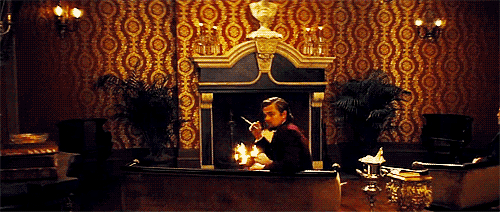
(This could not have been more narrowly targeted at me ahsgsgshshffgd)
Haigh! Excellent, always nice to meet others targeted by the same overlapping interest niches as me lololol
I was afflicted by the "I NEED this to exist and it does not yet exist in sufficient quantity soooo guess that's my cue" and then one book turned into three books and uh...here we are. It's got wlw and mlm ships and genderqueerness and polycules aligned with as much information as I could dig up on queerness in pre-modern Ireland which uh...isn't a lot, but there is some stuff and also the Greeks had some interesting things to say on the enthusiasm and frequency Keltoi warriors apparently engaged in queer (mlm) sex, which like....coming from them...probably says something
Also catch me out here shoving Old Irish vocab into the story. Language is culture and I want to invoke the real world they're living in, not some leprechanized version of iron age Ireland >.>
It's also a great excuse to explore my brain worms on the overlap of genetic population shifts and the mythohistory from the Book of Invasions (which yes it is an 11th century text made with different intent with parts added later so grains of salt but....there is still Alignment which is verrry interesting 👀)
Also finally...a place to indulge in "what if we take the magic described in folk tales at face value" and "what are these neolithic and bell beaker era lithics even for" (I got my hands on George Eogan's last textbook in the Knowth excavation series focusing on megalithic art styles and am steadily devouring the entire thing and CANNOT wait to integrate it into the magic system for the stone sites)
#i will stop ranting now#but so many of my interests are concentrated into the setting lol...#writeblr#historical fantasy
4 notes
·
View notes